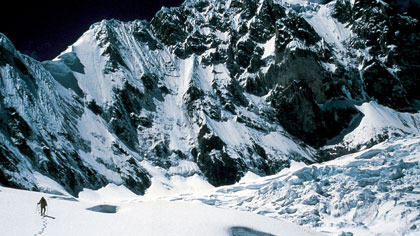
White Ladder
Film of the Month: Touching the Void

Touching the Void documents climber Joe Simpson's battle with pain and despair to escape death on a Peruvian mountain. By Richard Falcon.
Kevin MacDonald's gripping new documentary Touching the Void tells the story of an extraordinary escape from seemingly inevitable death. At its centre is mountaineer Joe Simpson, who at the age of 25 in 1985, with his younger climbing partner Simon Yates, successfully ascended the unclimbed west face of the remote Siula Grande in the Peruvian Andes only to confront a terrifying series of disasters on the descent. MacDonald's film may come 18 years after the event and 15 years after Simpson himself achieved literary fame with the publication of his international bestseller recounting the experience - also called Touching the Void - but it is far from an addendum. Touching the Void is a vivid cinematic experience proving that the grip on narrative momentum evident in MacDonald's 1999 Oscar-winning account of the 1972 Munich Olympics hostage crisis, One Day in September, remains as powerful as ever.
In the film Simpson describes the 'one push' method of ascent - sleeping in ice caves rather than setting up base camps en route - as the "purest" style of climbing and extols "freedom from clutter" as one of the main pleasures of such endeavours. Touching the Void's documentary style is similarly a highly focused, clutter-free experience, mixing recently shot to-camera interviews with Simpson, Yates and Richard Hawking (who remained in a base camp) with dramatic reconstructions. The form is familiar from TV reality series such as the BBC's 999, but MacDonald raises it to unprecedented levels of cinematic spectacle, suspense and apparent authenticity (Simpson and Yates accompanied the director to the Andes for part of the shoot).
When Simpson won the Boardman Tasker Award for non-fiction in 1988 it was pointed out that no fiction writer would dare to invent so implausible a story. That may be true, but Hollywood's way with mountaineering tends to focus on superhuman prowess - think Sylvester Stallone climbing a snow-covered mountain in a vest in Cliffhanger or Tom Cruise dangling Spiderman-like from a peak in the opening of Mission: Impossible II, both enabled partly by a seamless use of digital technology. (Cruise had at one point been in the frame for a feature-film version of Touching the Void.) The great strength of Simpson's book, though, is the immediacy of its narrative voice; as climber Chris Bonington points out in his introduction, Simpson is a rarity - not merely a risk-taking climber but a skilled writer able to describe his near-incredible survival story first hand.
MacDonald's task was to recreate that immediacy for the cinema. Instead of using passages from the book as narration, the film draws on fresh interview material to provide a running commentary and some sense of Simpson's and Yates' states of mind. Simpson must have told this story thousands of times, but the matter-of-fact description of events as he shatters his leg on the mountain and Yates attempts to lower him is even more powerful for its British understatement. Simpson, for instance, adds to the book's description of the moment when Yates abseils down the treacherous powdery cornice of snow to ask him if he's OK the recollection that he was about, as a reflex, to say, "I'm OK. I'm fine." But when he reveals that he has broken his leg, both men know this is likely to be a death sentence. The question is whether it need be for both of them.
The decisions that follow are at the core of the drama - MacDonald shrewdly perceives that we need to know little about these two men beyond their reactions to the situation. Pared down to its essentials, it's as horribly compelling as the opening balloon accident in Ian McEwan's novel Enduring Love, and we don't have to know a belay plate from a Prussik knot to be dragged along by it. At this point in Simpson's book his first-person narration gives way for the first time to Yates' thoughts, and in the film Yates maintains the same level of unflinching candour: "If he fell off I could make it down the mountain alone," he remembers thinking.
In the following passages, in which Yates inadvertently lowers Simpson over an overhanging ledge as a blizzard moves in, MacDonald's focus on recreating events as authentically as possible pays dividends. The director insisted on shooting both on the Siula Grande mountain and in the Alps, where heavy snowstorms add to the sense of isolation in which actors Brendan Mackey (as Simpson) and Nicholas Aaron (as Yates) and the stunt climbers recreate Simpson's plunge into a crevasse the size of the dome of St Paul's, and Yates' decision - still apparently controversial among mountaineers - to cut the rope connecting them. The arduousness of the shoot and the delight expressed by MacDonald in interviews on discovering that parts of the Siula Grande have never been filmed before call to mind Werner Herzog at his most adventurous. Herzog's own Bergfilm Schrei aus Steine (Scream of Stone, 1991) was a disappointment, but comparisons with his documentary Wings of Hope (1998), in which he returns to the Peruvian jungle with biologist Juliane Koepcke, who had miraculously survived a plane crash there, are telling for Touching the Void's perspective on documentary and extreme experience.
In Wings of Hope Herzog - like Nick Broomfield, Michael Moore and other ego-driven documeisters - becomes the subject of the film, colouring his Romantic obsession with the insoluble metaphysical mysteries of extreme survival tales with the fact that by chance he himself had missed the flight. MacDonald, instead, wants to make us feel as much of Simpson's pain and dread on the way to his extraordinary reprieve as the tools of narrative cinema allow. His shooting of the key sequence inside a real crevasse adds its own claustrophobia to Simpson's voiceover description, reminiscent of the Poe of The Pit and the Pendulum: "Crevasses have a dread feel, not a place for the living... I hung on the rope and waited to die."
Metaphysics and mountains are inseparable even in a pragmatic British context. Touching the Void adds religious choral music by Thomas Tallis to its stunning mountain shots; Simpson himself credits to his battle with resignation and despair the realisation that his devout Catholicism was behind him and he was now an atheist. Apart from his prolific writing career, Simpson is successful on the corporate lecture circuit where middle managers look to him for inspiration. In the film he explains the need to continue taking decisions and to break down the seemingly impossible task of making it down the mountain alone and injured into small, achievable goals. Those of us not climbing the mountain of monthly sales targets, though, can reflect instead on the cosmic significance of Simpson not wanting to die, dehydrated and frostbitten, on a Peruvian mountain with Boney M's 'Brown Girl in the Ring' inexplicably tormenting his delirium.
